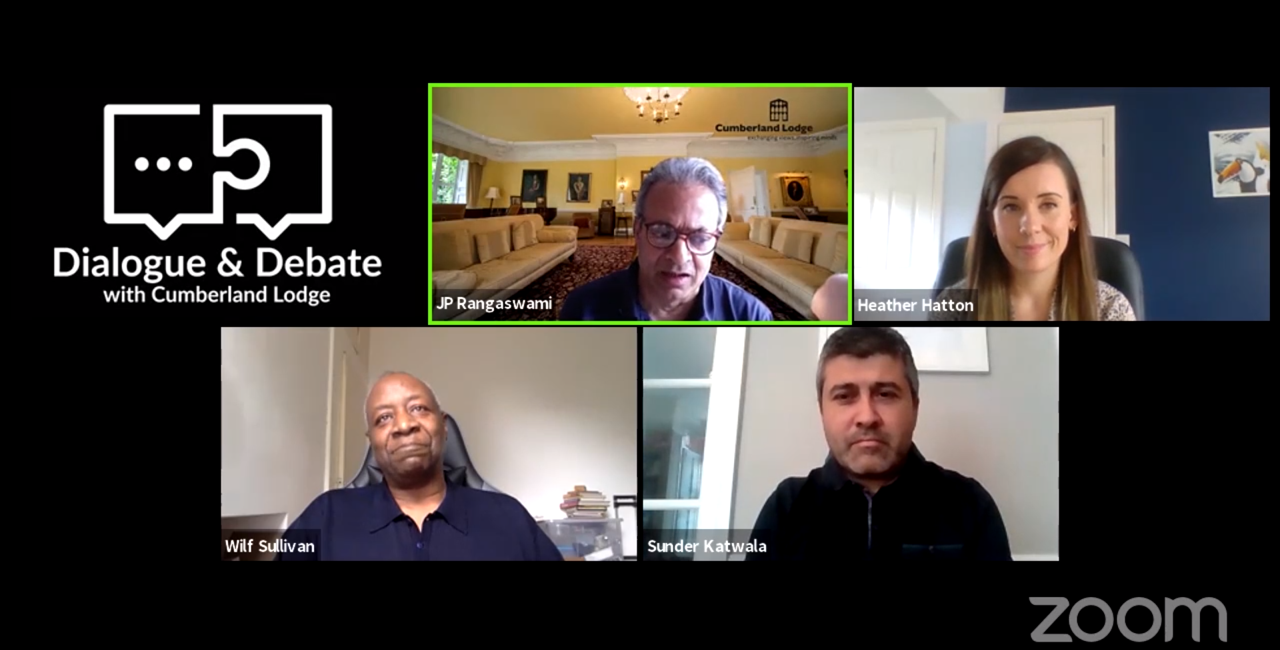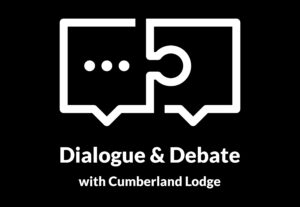On 16 July 2020, Cumberland Lodge hosted a Dialogue & Debate webinar as the final part of its four-part mini-series of webinars on the Black Lives Matter (BLM) movement, focusing on ‘Facing the Future’. It was hosted by Cumberland Lodge trustee and former Group Head of Innovation and Chief Data Officer at Deutsche Bank, JP Rangaswami, with guest panellists:
- Heather Hatton – PhD student at the History Department of the University of Hull and Cumberland Lodge Fellow
- Sunder Katwala – Director, British Future
- Wilf Sullivan – Race Equality Officer, Trades Union Congress (TUC)
Opening the debate, JP Rangaswami pointed out that the previous three webinars in the Dialogue & Debate: Black Lives Matter mini-series had highlighted the importance of acknowledging that significant problems of racial inequality still exist in the UK. He asked the panellists whether they felt the momentum around BLM was helping society to identify where these problems lay.
Wilf Sullivan said it has put the issue of race back on the agenda to be debated and presented an opportunity to change the narratives around race, but he questioned whether there had been a wholesale acknowledgement of issues such as institutional racism.
‘What is the purpose of a history education?’
Reflecting from her perspective as a former secondary school teacher, Heather Hatton stressed how BLM has stimulated reflection on responsibilities to educate ourselves about present-day inequalities and how they are the legacy of historical contexts such as Empire and colonialism.
Drawing on some of the themes that emerged in the recent Cumberland Lodge Report on Difficult Histories and Positive Identities, Heather stressed how the selection of particular historical narratives can result in the perpetuation of injustices, by continuing to privilege certain voices over others. She spoke about the importance of ‘coming together to create more representative historical discourses that are more nuanced, through the inclusion of a multiplicity of voices and perspectives’.
She also urged us to reflect on the very purpose of a history education, suggesting that its primary purpose should be to ‘[equip] students with the critical thinking skills that they need to challenge these power structures’, which perpetuate inequality.
A greater commitment to doing something, but what is that something?
Reflecting on the momentum behind the BLM movement, British Futures Director, Sunder Katwala observed that there seems to be an ‘increased commitment to do something’, but questioned whether we will see a ‘sustained change out of this moment of growing awareness’, which he acknowledged will be difficult.
Sunder highlighted that the debate around cultural representation has gained a lot of attention in the UK (most noticeably around the toppling of the statue of slave-trader Edward Colston in Bristol and the subsequent debate as to what to do with the statue, and repeated calls that “Rhodes must fall” in Oxford).
However, he warned that, although the debates around symbols matter, we must be careful that they don’t squeeze out other important debates in areas where challenges persist, such as in: ‘policing, crime and justice, history and identity, opportunity and education, which statues we want and don’t want’.
Echoing some of the earlier debate in this webinar series, Sunder stressed the importance of acknowledging that, although the present moment of awareness has been stimulated by the BLM debate in America, it is vital that the specificities of racial inequalities in Britain are given due attention – particularly the differences in experience amongst communities lumped together under the ‘BAME’ (Black, Asian and minority ethnic) banner (for example, challenges faced by various black communities in Britain which, despite some commonalities, are often very different to those faced by people of Indian, South-Asian Muslim, or other minority ethnic backgrounds).
Sunder talked about how it is important to take a nuanced view when discussing the experiences of different ‘BAME’ communities.
Looking to the future, he urged us to take a moment to reflect on the progress that has been made, to highlight what sort of actions have been successful and to reflect on how we can drive that success in the future.
‘Are we chatting too much and acting too little?’
JP asked the panellists how we can ensure that we don’t waste this opportunity of increased attention being given to issues of racial inequalities. ‘Are we chatting too much and acting too little?’ he proposed.
Responding to this, Heather highlighted the range of work being done by educators in attempts to decolonise the curriculum, in order to deliver more inclusive and representative history education. However, she also stressed the challenges presented by structures that require governmental intervention, in order for meaningful change to be brought about, such as altering the curriculum and exam procedures.
Heather agreed with the recommendations made by the Runnymede Trust, that school topics such as migration, which are key to understanding modern race relations in Britain, should be made compulsory. She pointed out that there are excellent resources available to help educators teach the complex and difficult European histories surrounding the Holocaust, and called for more funding for similar teacher training, resources and development around Britain’s ‘difficult histories’ in relation to colonialism and Empire.
Heather also noted that further progress could be made by increasing dialogue between higher education and secondary school teachers, in order for contemporary scholarship to ‘trickle down and permeate into school textbooks and classrooms’ and help to facilitate knowledge exchange.
For Wilf Sullivan, it was a question of what we, as a society, are trying to do when we educate young people. For him, part of the problem is that education has become about ‘preparing people for jobs rather than equipping them to deal with the real world’, and that while this is the case, ‘making people understand how we got here and how society is structured and what the dynamics are is not a priority’. This has resulted in diverse histories simply not being treated as a government priority.
All too often, Black, Asian and minority ethnic people have been left to self-educate their children through initiatives such as Saturday Schools, because they recognised that getting the state system to do that was a losing battle.
For Wilf, this lack of education surrounding the historical contexts of race relations in Britain is a key contributing factor to racial inequality in Britain today, as it allows the myth of meritocracy to thrive.
As Sunder noted, a study by the Institute for Social and Economic Research found that, although students from minority ethnic backgrounds are more likely to attend higher education than white Britons, graduates from non-white backgrounds are subsequently less likely to be employed, and face wage disparities when compared with their white colleagues.
Better off than our grandparents?
Sticking with the theme of meritocracy, Sunder highlighted that, although people with Black, Asian and minority ethnic backgrounds now have much more of a presence in public life than in previous decades, there is still a gap between government discourses of ‘equal opportunities for all’ and lived experiences.
Although Sunder’s own experiences of overt racism have diminished over the years, he noted that governments and organisations have failed to deliver on the promises of meritocracy, where those who work hard get ‘ahead’.
One point of debate that emerged was whether young Black, Asian and minority ethnic people today have higher expectations and more opportunities than their parents and grandparents had.
Sunder felt that the expectations of young people from minority ethnic communities had risen, and that the rising number of MPs from minority ethnic backgrounds, for example, means there is now greater potential for change. For example, the number of MPs from minority ethnic backgrounds has risen from just one in 40, ten years ago, to one in 10 at the last election.
In contrast, Wilf felt that his generation, who were born in Britain, had every expectation that they should be treated as equal citizens. However, he felt that young people from minority ethnic communities now face a far more precarious economic situation than their parents and grandparents, with ever-rising house prices, austerity measures and the gig economy reducing the economic stability available to them.
Wilf captured the frustration of ‘optical allyship’ when he observed that, ‘What the frustration is about is people ticking a box, saying the right thing, but never doing anything’. Acknowledging this powerful challenge to a narrative of progress, Sunder stressed the role of intersectionality and class, arguing for a more nuanced approach to so-called homogeneous ‘BAME’ communities, as social class also plays a powerful role.
What are the institutional responses required?
Thinking about the future, JP asked the panellists for their opinion on how best to capitalise on the momentum of the BLM movement to get the institutional and structural responses right, in order to convert this from a ‘call to action’ into ‘kinetic energy’ for change.
For Sunder, a commitment to ‘no all-white boards of organisations in the UK, by the end of next year’, would be a strong symbolic commitment to real change. He noted that, ‘A third of FTSE companies and a third of National Health Service (NHS) Trusts have all-white boards in the Britain of 2020, in which one in six citizens is “not white”’. When these organisations then tweet hashtags in solidarity with BLM and ask what they can do, they are creating emotional labour for people of colour, whilst taking no real action themselves.
By making a commitment to include voices from ethnic minority communities on their boards’ organisations, they can build a ‘foundation to take further action about what [they are] going to do over the next few years in [their] institutions’.
For Wilf, institutions have, for far too long, ‘externalised the problem of race’. Despite the findings of the 1999 Lawrence Report (also referred to as ‘The Macpherson Report’, into the death of Stephen Lawrence in 1993) ‘they haven’t accepted that there is such a thing as institutional racism, and when they do accept it, it’s about ticking a box’.
Wilf was critical of people who construct racism through ‘a deficit model’, which views the problem as lying with black people, rather than focusing on changes that people in power can make within their institutional cultures.
Wilf stressed that having black people on boards doesn’t make much difference if the culture of the organisation is left unchanged. If people fail to recognise that we really need to fundamentally change institutional cultures, then nominal inclusion makes little difference to the experience of inclusivity, the feeling of belonging.
Individual actions for facing the future
Sharing his closing thoughts, Wilf highlighted two main points for action:
- Echoing some of the issues raised in the Black Lives Matter: Policing & Community webinar, we must demand more accountability in policing. Police officers should explain why they have stopped someone to search them, and more broadly, we should be examining the way that resources are deployed to police black communities. This would create more police accountability, reflexivity and the potential to build greater trust in communities.
- We must demand positive action beyond just equal opportunities. Equal opportunities are important but they ‘don’t redress the damage and the deficit black communities have faced as a result of institutional racism over centuries.’
In response to critiques that positive action is unfair, Wilf highlighted the fact that positive discrimination has favoured white people for centuries and that, ‘if we are serious about having a racially equal society, then we have to look not only at providing equal opportunities, but [at] how we redress that balance.’
Wilf closed by emphasising that, ‘We need to stop pretending that we are living in a meritocracy, because we’re not’ – education and qualification do not always ensure equal opportunities.
Offering his closing thoughts, Sunder urged us to ask the following question: when we have seen progress, what made it work and where we haven’t what made it fall short? He also called for much closer contact and sharing between inter-ethnic communities, in order to help people recognise commonalities and mobilise towards collective action on issues of race.
Sunder offered a challenge to the approach that foregrounds ‘empathy, dialogue and listening’, which is valuable in some ways, but can lead people to think that a ‘therapeutic approach to diversity training is an alternative to changing your institution.’ He urged us all to ask ourselves, ‘What are your timetabled commitments this year?’
Sunder left us with the rally cry to, ‘Make the change that is in your power!’
My reflections on ‘Facing the Future’
As a Cumberland Lodge Scholar and a PhD student researching the uses of the past in present politics, I have done a great deal of personal reflection on the difference I can make in promoting racial equality.
Facing one’s own white privilege can sometimes be an uncomfortable process. I’ve asked myself whether I should be writing about these issues at all, when there are so many other people better qualified to speak about them.
Am I just replicating the problems that have seen white people speak for, and over, people from Black, Asian and other minority ethnic communities? Was feeling like this just me centring myself through my own ‘white fragility’? Am I just an ‘optical ally’, described by Latham Thomas, in a viral social media post by Mireille Charper, as ‘allyship that only serves at the surface level to platform the “ally”; it makes a statement but doesn’t go beneath the surface and is not aimed at breaking away from the systems of power that oppress’.
However, listening to these debates, I strongly recognise Heather’s observations that to work towards an anti-racist society, we must confront our own biases.
When I was educated in Canada in the 1990s and early 2000s we were taught that building a multicultural society was about “not seeing colour”, that “we are all the same” and “just people”.
I think one of the strongest messages to emerge from the recent Black Lives Matter movement is that this so-called “colour blindness” is just that; blindness. It fails to see white privilege, fails to appreciate the structural challenges faced by people from Black, Asian and minority ethnic communities, and fails to acknowledge that even if were are not actively racist by doing nothing, we are still complicit in building a society in which white people still overwhelmingly and disproportionately sit in positions of power and influence.
It is not enough to hold inclusive values and beliefs: in a society in which structures and socialisation have produced unconscious racial biases, we must seek to individually work towards an anti-racist society. As Wilf notes, we must be prepared to radically alter our institutional cultures and take positive action.


